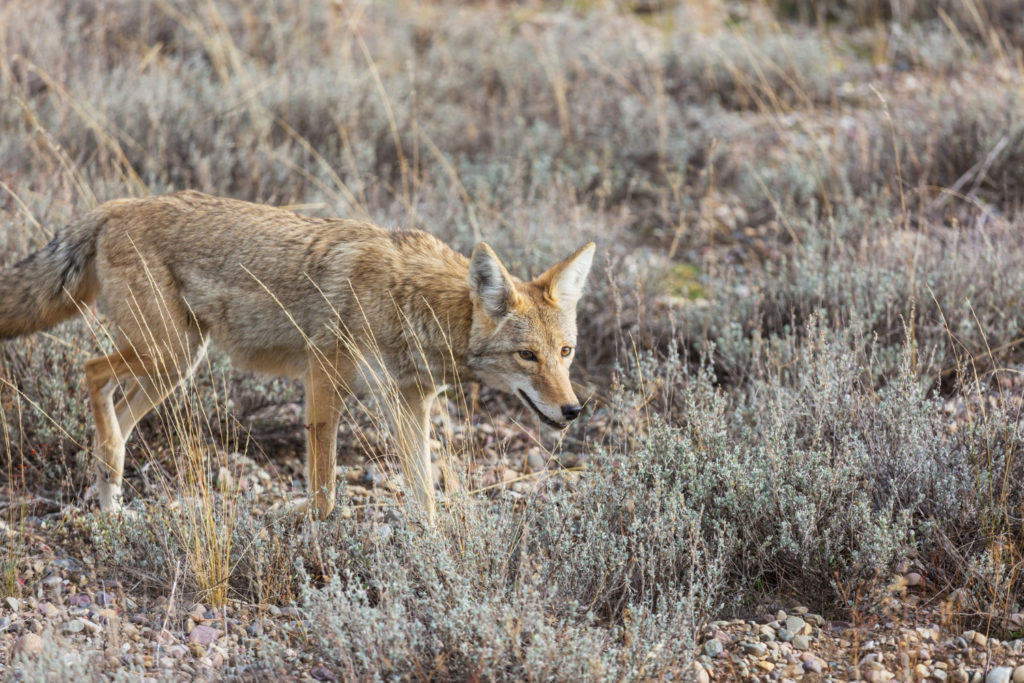
GUIDELINES to follow when you see a coyote…
…crossing a yard or street
Coyotes are most frequently seen and heard during mating season (January-March) and when juveniles start leaving the family pack (September-November). While normally fearful of people, they can sometimes be spotted crossing yards or streets. This behavior is not unusual, especially in residential areas bordering on open space where coyotes find their natural prey. They may simply be taking a shortcut to their favorite hunting ground. This type of sighting generally requires no response – other than making sure that pets and children are secure and that there are no likely food attractants present in the area.
…lounging in a yard or approaching/following people
Coyotes are naturally timid animals and will usually flee at the sight of a human. If they linger or approach, it’s time to begin “hazing.” This is a term applied to the following actions that can be taken to scare coyotes and chase them away:
- Be as big and loud as possible.
- Do not run or turn your back.Wave your arms, clap your hands, and shout in an authoritative voice.
- Make noise by banging pots and pans or using an air horn or whistle. These sounds can also alert the neighbors.
- Throw small stones, sticks, tennis balls or anything else you can lay your hands on. Remember the intent is to scare and not to injure.
- Spray with a hose, if available, or a squirt gun filled with water and vinegar.
- Shake or throw a “coyote shaker”—a soda can filled with pennies or pebbles and sealed with duct tape.
The effects of hazing may not last unless all food attractants are permanently removed. This information should be shared with neighbors, friends and homeowner’s associations since hazing is most effective when the entire neighborhood is working together.
Hazing should never be attempted if the coyote is accompanied by pups or appears to be sick or injured. If it’s the latter, call the Police Department. They will contact the Animal Warden for assistance.
…failing to respond by hazing
Some coyotes may freeze and stare, or run a short distance and stop. Hazing should be continued until the coyote gets the message and finally leaves the scene. Hazing can work whether the encounter is with a lone coyote or a small pack. If the leader retreats, the rest of the pack will follow. If the coyote refuses to retreat or returns to the area despite persistent hazing, it may be due to the fact that someone is feeding coyotes nearby. This is a cause for concern and should be reported to the Police Department.
…approaching a pet or child
Small pets and children should never be left unattended, and dogs should always be walked on a leash. Problems are more likely to occur when the animal is out of the owner’s control. It can also be helpful to carry a noisemaker, squirt gun or pepper spray. If a coyote approaches, pick up the pet or child, then start hazing. If the coyote does not leave, back away slowly while continuing to haze and go indoors if possible. Any aggressive behavior should be reported to the Police Department.
Safety Tips for Pet Owners:
While coyote attacks on people are rare, pets are not so lucky. Those that are small or elderly are especially at risk. By taking the actions listed below, their owners will greatly improve their odds:
- Never leave pets outside and unattended, even during daylight hours.
- Avoid feeding pets outside if at all possible. Or feed them during the day and remove all bowls when finished.
- Remove all food attractants from the yard, including fallen fruit.
- Clean areas around bird feeders and store feed indoors.
- Keep lids on garbage cans and cover compost piles.
- Rinse out food containers to remove odors that might attract coyotes. Do the same with outdoor grills.
- House backyard chickens in secure and protected coops.
- Close up crawl spaces under porches and sheds to prevent wildlife access and denning.
Some people claim success with predator urine such as wolf or mountain lion to keep coyotes out of their yards. While this approach may seem logical, there is very little hard evidence or research to support it.
Special tips for dog owners: Dogs smaller than 40 pounds are often regarded by coyotes as prey. They should never be left outside unattended, especially after dark. Larger dogs may also be attacked if they intrude on a pack’s territory and are seen as a threat or competitor. All dogs should be walked on a leash, which increases the owner’s control, but never tied up alone in the yard, which increases their vulnerability.
Special tips for cat owners: If there are coyotes in the area, a safe cat is an indoor cat. Period.
This information is from: https://www.coyotesmarts.org/ (visit the site for additional information)
Other resources include:
- Coyotes: Discover & Learn (ODNR)
- What To Do If You See a Coyote (YouTube)
- Urban Coyotes: Conflict & Management (The Ohio State University Fact Sheet)
